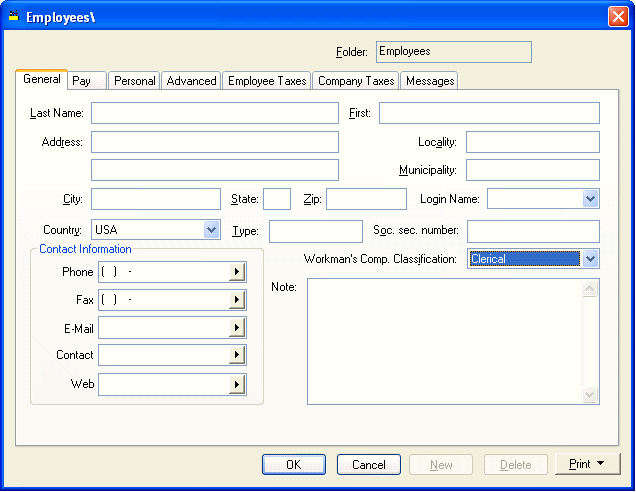 The Employee window appears very similar to the Employee entry window, but is used only to enter default values. Any data entered in any of the entry fields will default the next time you enter a new employee in the main employee entry window.
The Employee window appears very similar to the Employee entry window, but is used only to enter default values. Any data entered in any of the entry fields will default the next time you enter a new employee in the main employee entry window.It is wise to set employee folder defaults before entering new employees. If you are not familiar with editing defaults review the Change Defaults, Filter Down data and Globally Editing data section. To continue, go to Payroll > Options and click on Employee Folders tab. Click on the root folder named Employees and click the Edit Defaults button. The following window will appear:
 The Employee window appears very similar to the Employee entry window, but is used only to enter default values. Any data entered in any of the entry fields will default the next time you enter a new employee in the main employee entry window.
The Employee window appears very similar to the Employee entry window, but is used only to enter default values. Any data entered in any of the entry fields will default the next time you enter a new employee in the main employee entry window.
EXAMPLE If you set the country entry field default to "USA" then you will not need to enter USA into that field when entering a new employee.
For more details on individual fields, go to the Payroll > Employees > Entering New Employees section.
General Tab
Most of the information on the General tab will remain blank with the following exceptions:
· Set the Contact Information field labels to reflect the most common contact information that you obtain from your employees. Click on the right arrow button to the right of each of the 5 entry fields and you will be able to select a variety of labels.
· Set the Workman’s Comp. Classification to the most common classification used for new employees. If you do not wish to have this field default to a classification, keep the field blank.
Pay Tab
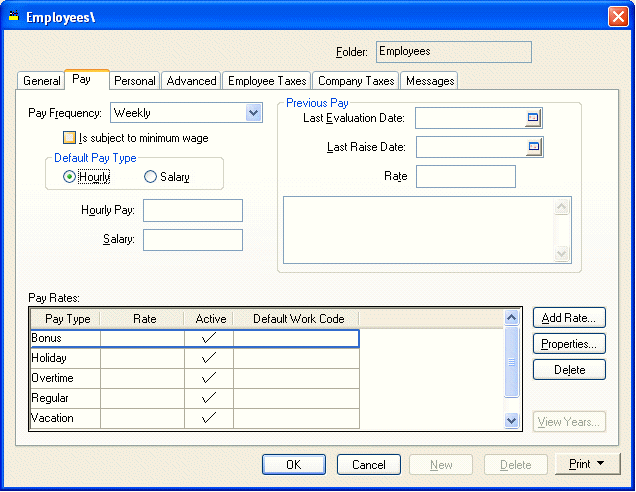
· Dates and pay should be kept blank and be entered at the employee level.
Credit Workweek Amount is the minimum dollar amount an employee needs to work to become eligible for state benefits such as Workers’ Compensation. This total should be set within the default folder before new employees are added. If this total changes for all employees, filter down default amounts to all existing employees. Review the Change Defaults, Filter Down Data, and Globally Editing data section for more details.
Pay Frequency should be set to the length of the normal payroll period such as Weekly or BI-Weekly.
Default Pay Type should be set to the most common pay type, Hourly, or Salary.
Perform the following steps to setup defaults in Pay Rates table:
1. To add a rate to the list, click on the Add Rate button. The following dialog will appear:
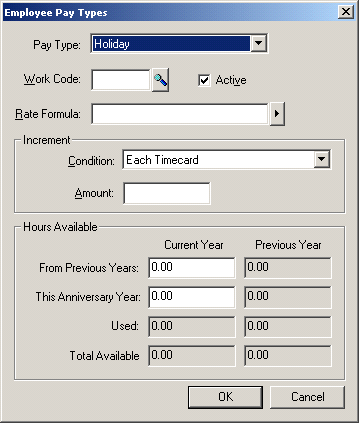
2. Select the new Pay Type you wish to list on all new employees. You must create new pay types in the Pay Types tab within the payroll Options window. See the Pay Types section for details on how to create new pay types.
3. Enter the default Work Code associated with this pay type. Let the work code field blank if you do not wish to default a work code for a new employee. See the Work Codes section for details on the function of a work code.
4. The Rate Formula is only useful when pay types are Hour based. Go to Payroll > Options > Pay Types tab to identify Hour and Dollar based pay types. The Rate Formula is calculated from the employee Hourly Pay rate amount as consists of two parts.
Select the formula template by clicking on the right arrow and choose one of the available templates.
Fill in formula values such as percentages or dollar values.
EXAMPLE:
· Select Add ___ % formula and enter the formula value of 50 to create formula Add 50 %. This formula would be appropriate for an overtime pay type since the rate would be the pay rate + 50 %, or time and a half.
· Select Add $___ formula and enter the formula value of 1 to create formula Add $1. This formula would add $1.00 to the hourly pay rate whenever this pay type is used.
· Select Equal to formula whenever the pay rate is equal to the hourly rate. This is the standard formula for regular pay.
Increment fields are only used for benefit pay types that are limited such as vacation or sick days. See the Payroll > Options > Pay Types tab to identify the Benefit pay types. If you do not limit this pay type, ignore all Increment field entries.
Increment Condition - choose one of the following options:
· Each Time Card will increment the available benefit hours each time a timecard is processed.
· Beginning of Year will increment once at the beginning of the calendar year.
· Employee’s Anniversary will increment once a year on the anniversary of the Hire date.
· Manual Entry will not increment the Hours Accumulated amount automatically but will require manual entry of hours accumulated.
· The Amount field reflects the amount that Hours Accumulated should be incremented every time the Increment Condition is TRUE.
· Hours Accumulated field reflects the total accumulated hours. See total available hours within the pay list. Available hours = Hours Accumulated – Total Hours Used - Click View Years button to view Total Hours used for each year.
Click OK to save or Cancel to abort.
5. Click Properties button to edit Pay Types. Field properties are explained in Add Rate section above.
6. Click Delete to remove pay type from employee’s pay type list. You cannot delete a pay type if pay history is present.
7. The View Years button is disabled in this default section. A specific employee must be selected to use this function. Review the Changing Employee Information section for more details.
Personal Tab
Keep the personal tab blank since this information should be set for each employee.
Advanced Tab
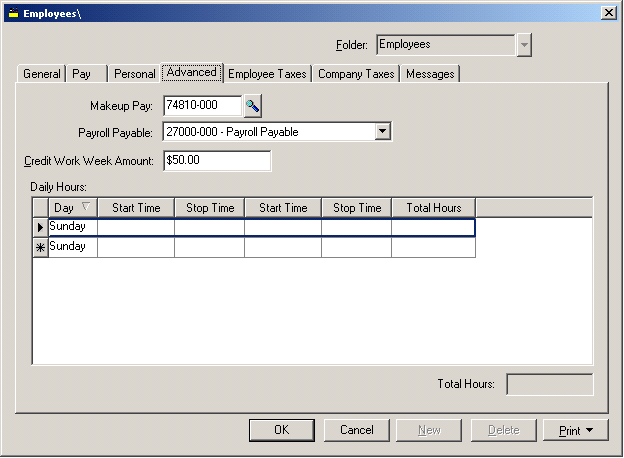
Set the Makeup Pay general ledger account as an expense account to record any makeup pay that is paid to an employee. Makeup pay is added to an employee’s pay and must meet minimum wage requirements. See the Payroll > Timecards > Minimum Wage and Makeup pay section for more details.
Set the Payroll Payable general ledger account, which requires an account with a Payroll Payable classification. If no account is available go to General Ledger > Chart of Accounts and add a liability account with a Payroll Payable classification.
Keep the Daily Hours blank unless you wish to enter the normal working hours that any new employee will work. See Daily Hours section for more details.
Employee Taxes Tab
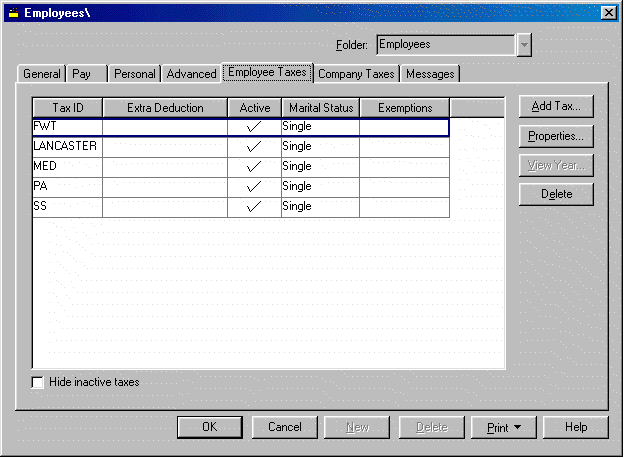
It is recommended that you list all common employee taxes and deductions so they are defaulted whenever a new employee is added. If the employee tax and deductions are not setup go to Payroll > Taxes / Deductions and enter tax and deduction codes and rates before continuing with the following steps.
If any taxes or deductions are listed that are not used for your average employee, delete them by highlighting the deduction and clicking the Delete button.
Add any new taxes and deductions by clicking Add Tax. The following dialog will appear:
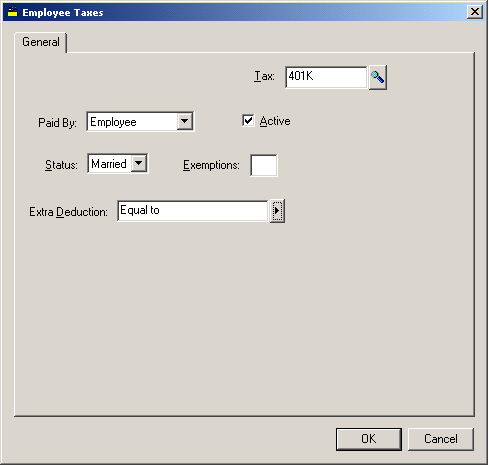
Select the Tax you wish to add by clicking on the down arrow. To create a new tax or deduction, go to Payroll > Taxes/Deductions > Tax tables. The most common employee taxes are FWT, FICA, MED, a state withholding tax and possibly a local tax. Also, add any company wide employee deduction. For more information on how to set up taxes, see Taxes and Deductions section.
All other fields in this dialog should be kept blank until setting up a new employee.
Company Taxes Tab
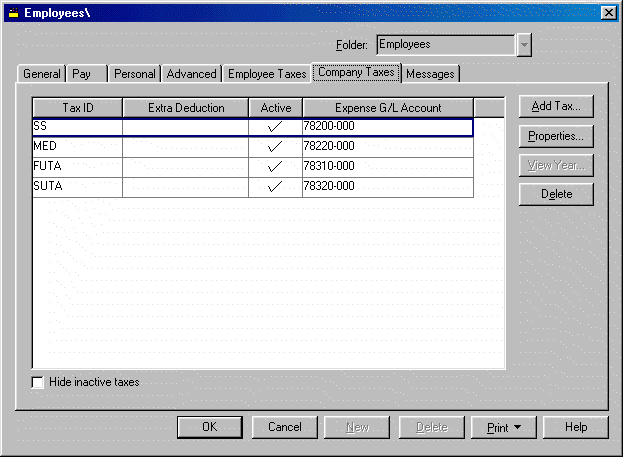
Setup the common company taxes such as state and federal unemployment taxes and the company portions of FICA taxes and Medicare taxes.
If any taxes or deductions are listed that are not used for your average employee, delete them by highlighting the deduction and clicking the Delete button.
Add any new taxes and deductions by clicking Add Tax. The following dialog will appear:
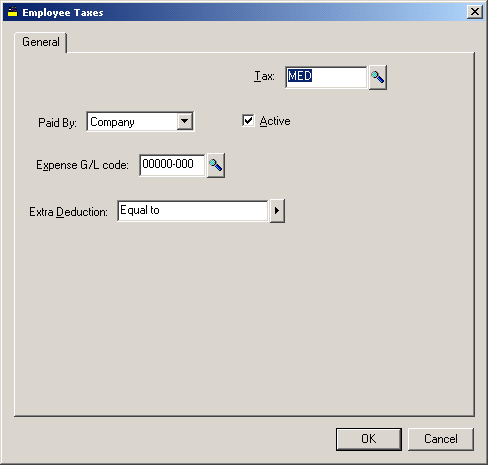
Click on the lookup button to view the available taxes and select the Tax you wish to add. To create a new tax or deduction, go to Payroll > Taxes/Deductions > Tax tables.
All other fields in this dialog should be kept blank until adding a new employee, with the exception of Expense G/L. Enter an expense general ledger account to record company tax expenses for each tax list in the Company Taxes tab.
Messages Tab
This tab can be used to enter any global messages that appear when certain procedures are performed. For details, see the Message section.
If subfolders exist and you wish to copy the default values from the root folder into the subfolders, drill down the default value for each entry field in each tab. See Filtering Down Defaults To Subfolders section for detailed instructions on this process.
Click the OK button to return to the Employee Folders tab.
Repeat the steps above if you wish to set different default settings for subfolders than the ones set for the root vendor folder.